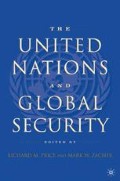Abstract
Controlling the risks posed by weapons of mass destruction (WMD)—nuclear, chemical, and biological weapons—has been high on the agenda of the United Nations (UN) since its inception. Despite the fact that the UN Charter places little emphasis on arms control and disarmament, the very first General Assembly resolution in January 1946 called for the new UN Atomic Energy Commission to make proposals for “the elimination from national armaments of atomic weapons and of all other major weapons adaptable to mass destruction.”1 Since then, the UN has viewed reducing the risks to peace and security posed by these especially destructive weapons as one of its major tasks.
I would like to thank David Malone, Randy Rydell, and the editors of and participants in this project for helpful comments on earlier versions of this chapter.
Access this chapter
Tax calculation will be finalised at checkout
Purchases are for personal use only
Preview
Unable to display preview. Download preview PDF.
Notes
Rebecca Johnson, “NPT Report: The 2002 Prepcom: Papering Over the Cracks?” Disarmament Diplomacy 64 (May–June 2002 ).
See George Perkovich, India’s Nuclear Bomb: Impact on Global Proliferation ( Berkeley: University of California Press, 1999 ).
Fiona Tregonning, “CWC Report: Emerging from a Trial By Fire?,” Disarmament Diplomacy 67 (October–November 2002): 4.
Jonathan Tucker, “Farewell to Germs: The U.S. Renunciation of Biological and Toxin Warfare, 1969–1970,” International Security 27(1) (Summer 2002): 107–148.
Joseph Cirincione et al., Deadly Arsenals: Tracking Weapons of Mass Destruction ( Washington, D.C.: Carnegie Endowment for International Peace, 2002 ), 31.
Oliver Meier, “Bare-Bones Multilateralism at the BWC Review Conference,” Arms Control Today (December 2002), 1.
Seymour Hersh, “Saddam’s Best Friend: How the CIA Made it A Lot Easier for the Iraqi Leader to Rearm,” New Yorker (April 5, 1999 ).
Susan Wright, “The Hijacking of UNSCOM,” Bulletin of the Atomic Scientists (July/August 1999 ).
Steven R. Weisman, “A Long, Winding Road to a Diplomatic Dead End,” New York Times (March 17, 2003 ).
Seth Mydans, “North Korea Says it is Withdrawing from Nuclear Arms Treaty,” New York Times (January 10, 2003 )
Steven R. Weisman, “North Korea’s Nuclear Plan Called ‘Unacceptable;’ Bush Seeks Diplomatic Solution,” New York Times (December 14, 2002 ).
See, for example, Edward C. Luck, “Making the World Safe for Hypocrisy,” New York Times (March 22, 2003), AU
Anne-Marie Slaughter, “Good Reasons for Going Around the UN,” New York Times (March 18, 2003), A33.
Evan Thomas, “How We Got Here: The 12 Year Itch,” Newsweek (March 31, 2003), 54–65.
Glenn Kessler and Mike Allen, “U.S. Missteps Led to Failed Diplomacy,” Washington Post (March 16, 2003), A15.
Nicholas Lemann, “How it Came to War,” The New Yorker (March 31, 2003 ).
Simon Chesterman and David Malone, “The Fate of the Security Council,” International Herald Tribune (January 27, 2003 ).
Ved Nanda and David Krieger, Nuclear Weapons and the World Court ( Ardsley, NY: Transnational Publishers, 1999 ).
Rebecca Johnson, “CD Closes 2002 Still Deadlocked,” Disarmament Diplomacy 67 (October–November 2002): 9.
Editor information
Copyright information
© 2004 Richard M. Price and Mark W. Zacher, eds.
About this chapter
Cite this chapter
Tannenwald, N. (2004). The UN and Debates over Weapons of Mass Destruction. In: Price, R.M., Zacher, M.W. (eds) The United Nations and Global Security. Palgrave Macmillan, New York. https://doi.org/10.1057/9781403980908_1
Download citation
DOI: https://doi.org/10.1057/9781403980908_1
Publisher Name: Palgrave Macmillan, New York
Print ISBN: 978-1-4039-6391-8
Online ISBN: 978-1-4039-8090-8
eBook Packages: Palgrave Political & Intern. Studies CollectionPolitical Science and International Studies (R0)

